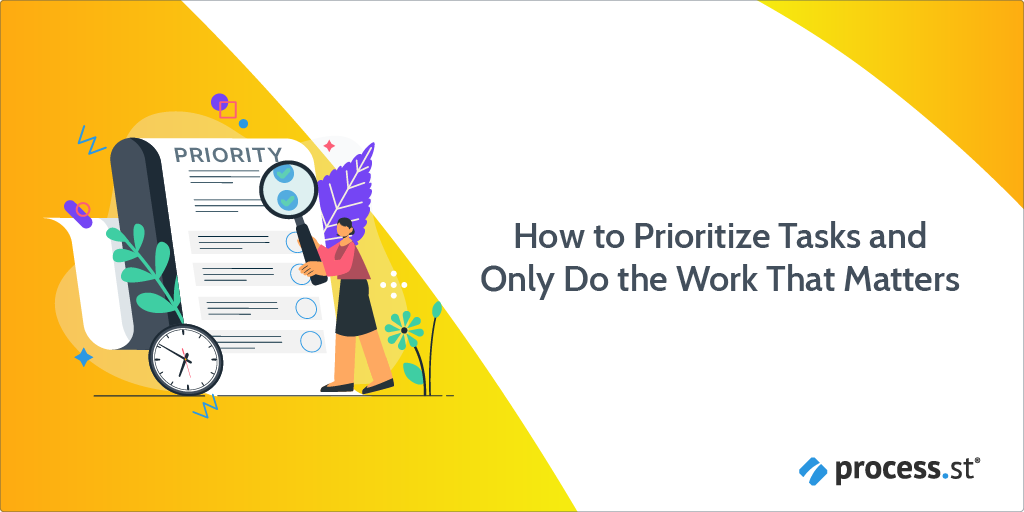
You’ve got a ton of work to do right now. Your to-do list is an unstructured mess of action items, and you’ve only got a faint idea how to prioritize tasks.
Luckily, there are a few (almost automatic) ways to quickly get your to-do list prioritized without much effort. In fact, you can apply one of these methods within 5 minutes and know exactly what to do next. There have been a number of methods over the years, and all have their own quirks and considerations. Which is right for you?
In previous chapters of my task management guide, I’ve taken you all the way through from writing, organizing, and planning your to-do list. Check those out if you haven’t already.
Now, I’m going to take you through a few of the ways I prioritize my tasks as a content writer for Process Street.
- Think about the process
- Slot your tasks into 4 boxes – Urgent vs Important
- When you have two frogs to eat, eat the ugliest one first
- Use the ABCDE method for precise prioritization
- The simplest method: Pick your 1-3 most important tasks
- Prioritize task prioritization today!
Think about the process
Before we get into the nitty-gritty of task prioritization, let’s think about the process. After all, a well-established workflow process is the foundation your tasks are built on. To properly prioritize your tasks, you need to ensure your processes are where they need to be.
How do you do this? The right process documentation is a must when it comes to structuring your processes. Having this documentation helps you execute your processes. It highlights the exact steps needed to complete a task from start to finish. Think of it as a roadmap to your desired destination.
Knowing what streets lead you there quickest is always the best way forward. Let’s face it, the price for gas isn’t what it once was, so you’re going to want the fastest route to your destination. It’s the same with your processes.
Knowing what tasks should be completed and what order they should be done in can help keep the process moving smoothly. In this instance, you aren’t saving on gas, you’re saving time and resources. Process Street’s Pages is one place where you can do this process documentation to help keep those ‘gas prices’ low
Now, we can look at how you can prioritize the tasks within your process to better your productivity and efficiency.
Slot your tasks into 4 boxes — Urgent vs Important
Here’s a task prioritization method from former U.S. President Dwight D. Eisenhower.
In 1954, he said:
“I have two kinds of problems: the urgent and the important. The urgent are not important, and the important are never urgent.” — Eisenhower
It was this quote that created the Eisenhower Matrix: a 4-box system for organizing your tasks by urgency and importance, then getting them done.
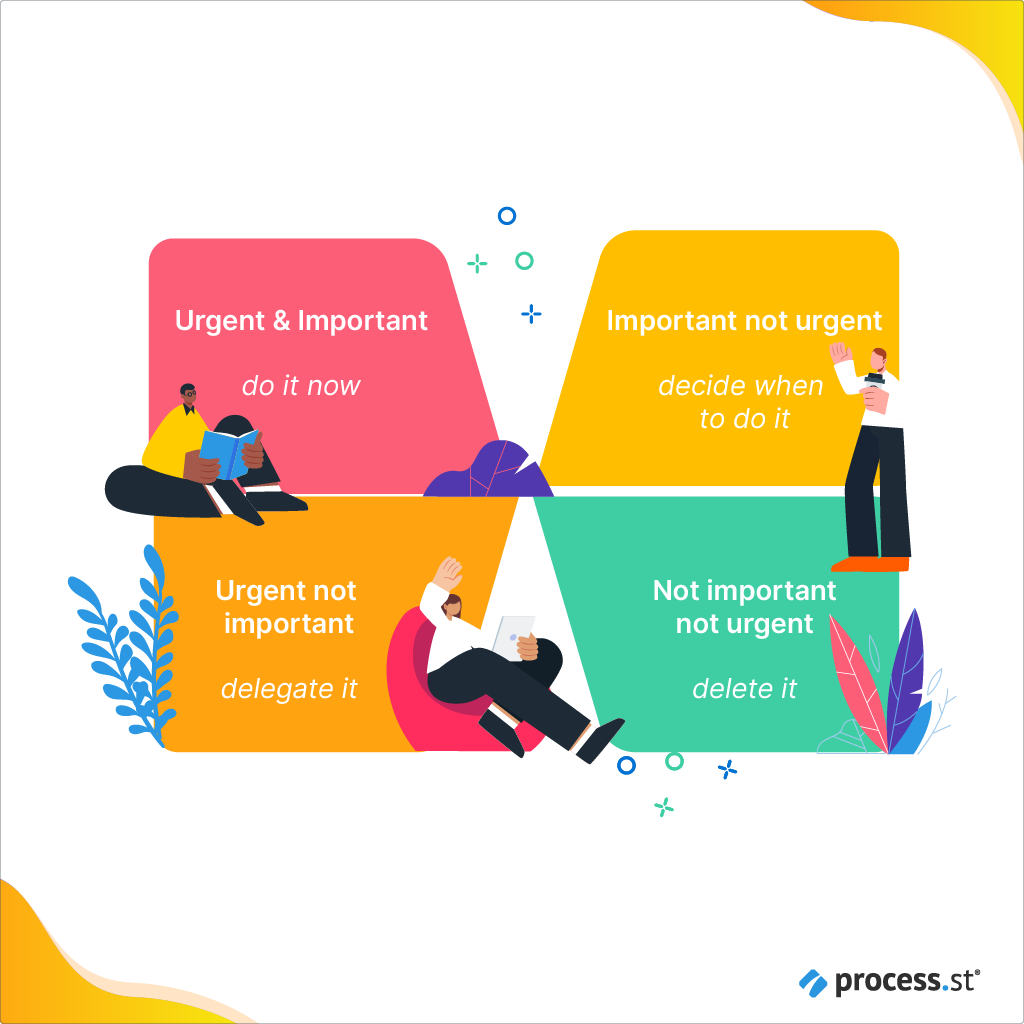
The Eisenhower Matrix puts tasks into 2 categories, then prioritizes them for you. It’s a fast way to get everything in order at the start of the day.
Action: Get into the habit of quickly categorizing tasks by using this checklist on your to-do list:
Defining the ‘important’ checklist
- Will it affect many people or projects if left incomplete?
- Are other tasks dependent on its completion?
- Does it contribute a lot of value?
- Does it offer low effort-high results (80/20 principle)?
Defining the ‘urgent’ checklist:
- Is it overdue?
- Is it due soon?
- Does it demand immediate attention?
- Are there immediate consequences if this task is left undone?
To apply the matrix to your to-do list, use tags to denote which quadrant of the matrix it falls into. From top right to left, you’ve got:
- Urgent AND important
- Important NOT urgent
- Urgent NOT important
- NOT urgent OR important
When I check this against my semi-fictional task list in Pages, it’s easy to see what’s a priority and what isn’t:
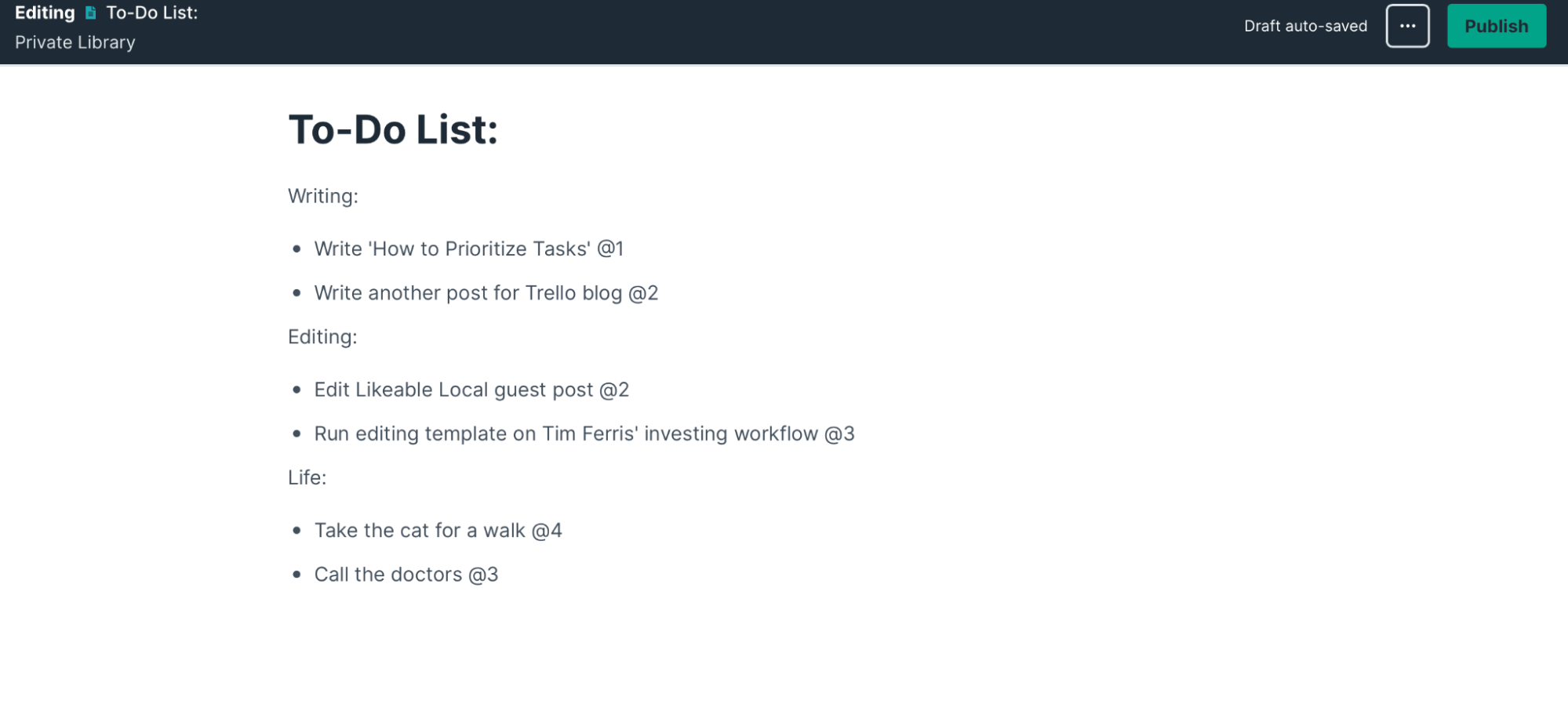
The Eisenhower Matrix saves the day!
When you have two frogs to eat, eat the ugliest one first
In slight contrast to the Eisenhower Matrix, Brian Tracy’s method of consuming amphibians focuses on your feelings towards the tasks on your list.
In the words of Mark Twain, “if you eat a live frog each day for breakfast, nothing worse can happen for the rest of the day.” And so, the idea is to eat the worst frog as early as possible then breeze through the day. Replacing frogs with tasks, how does this method work? You categorize tasks into 4 boxes, of course.
- Things you don’t want to do, and actually don’t need to do.
- Things you don’t want to do, but actually need to do.
- Things you want to do and actually need to do.
- Things you want to do, but actually don’t need to do.
The logic is, that if you don’t want to do a task, it’s probably because it’s hard. You know it’s important but you’re procrastinating. Get the biggest, ugliest task out of the way as soon as you can, and the rest will come easily.
You can use the same tagging method of 1-4 like I demonstrated above, or you can apply this methodology to one of the 7 task management lists I’ve previously outlined.
Use the ABCDE method for precise prioritization
The next method here from Brian Tracy is a little more mathematical. I love how it takes into account that different tasks can take the same priority level. Instead of randomly doing equal-priority tasks as they come along, the ABCDE method has two levels of priority. Here are the steps to take to prioritize your tasks with this method:
- Going through your list, give every task a letter from A to E, A being the highest priority and E being the lowest.
- For every task that has an A, give it a number which dictates the order you’ll do it in.
- Repeat until all tasks have letters and numbers.
So, for example:
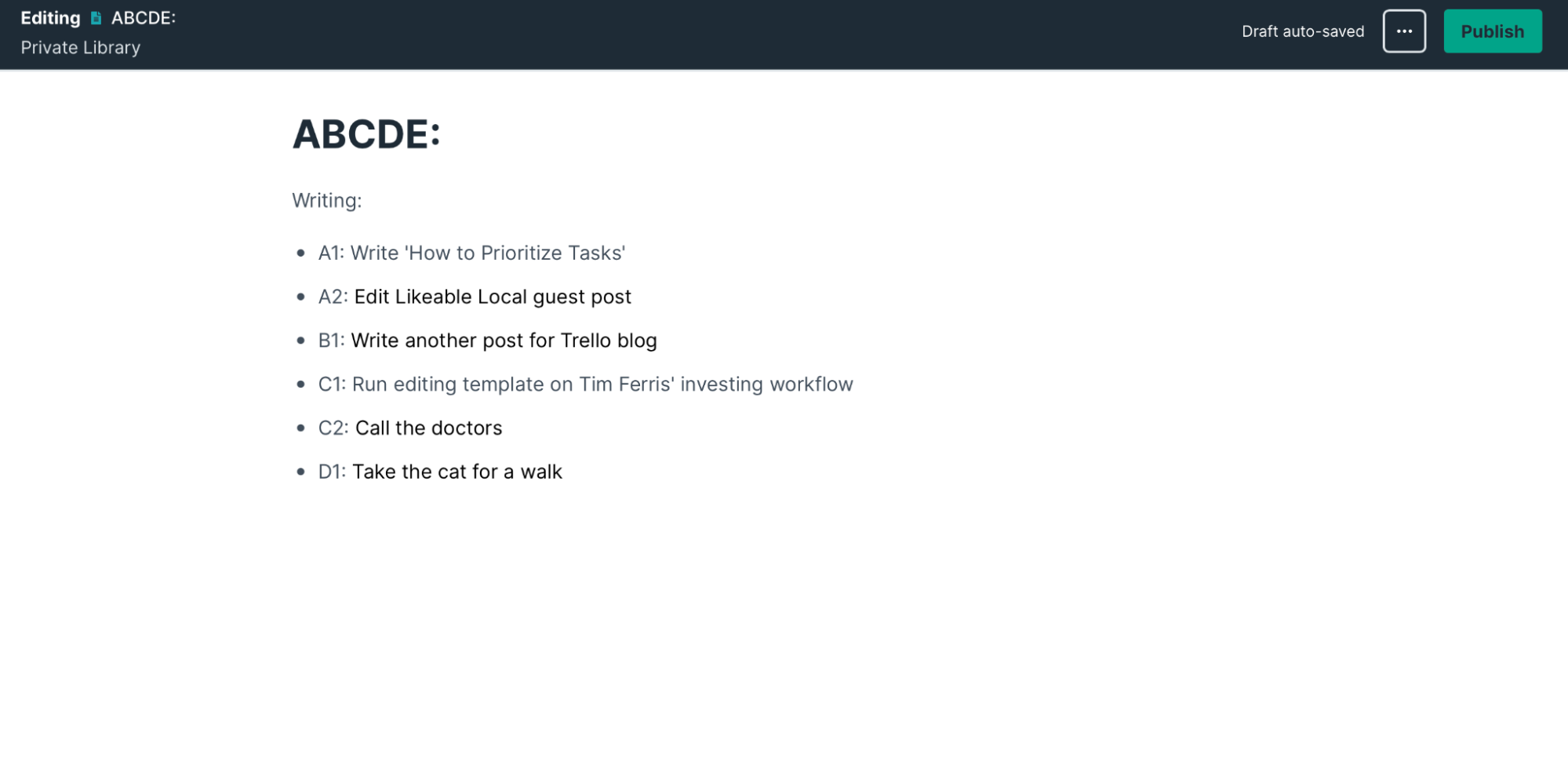 To make sure there’s a point in categorizing them so strictly, you’re going to have to be hard on yourself. You’re not allowed to start on a new letter until the previous letter is fully complete.
To make sure there’s a point in categorizing them so strictly, you’re going to have to be hard on yourself. You’re not allowed to start on a new letter until the previous letter is fully complete.
If you reference this against the other two methods I’ve outlined already, your A tasks would be your urgent and important frogs.
The simplest method: Pick your 1-3 most important tasks
True to form, the simplest way to prioritize your tasks comes from Zen Habits. In the book Zen to Done, Leo Babauta says:
“At the beginning of each day, review your list, and write down 1-3 MITs [most important tasks] that you’d like to accomplish for the day. That’s your whole planning system. You don’t need any more than that.”
Using the other methods in this article, you should be well equipped to pick your 1-3 MITs quickly, and get on the path to hitting to-do list zero.
The beauty of this method, however, is that it relies on your intuition. After you’ve been on a few projects, or swamped by an overpowering to-do list enough times, you instinctively know which tasks are your most important.
In the end, there’s not a complete mathematical formula for working it out, but there are some ways to make prioritizing your tasks a habit, and a skill you can hone to get work done faster.
Prioritize task prioritization today!
Getting work done can be an uphill battle if you feel overwhelmed with the amount of tasks on your to-do list. Luckily, after reading this article, you should have a better understanding of task prioritization.
The goal has – and is always going to be – to work smarter, not harder. Process Street can help with that! With its easy-to-use no-code software, you can document your processes to help you highlight what tasks should be taking priority.
When combining Pages with your Workflows, you aren’t just documenting your processes to see where you can prioritize. You can also give your team access to this information, so that everyone is one the same page to make actionable workflows that get your most important and urgent tasks done when they need to be.
Want to start boosting your productivity and reap more from the limited 24 hours you have in a day? Process Street can help you achieve just that. Its dynamic process management software helps teams get the most out of their efforts.
With features like automations, role assignments, dynamic due dates, and more, team members know what they need to do, when they need to do it, and are given the capability to automate the rest. Sign up now!
Which task prioritization method did you find the most useful? Let us know in the comments below.







 Workflows
Workflows Forms
Forms Data Sets
Data Sets Pages
Pages Process AI
Process AI Automations
Automations Analytics
Analytics Apps
Apps Integrations
Integrations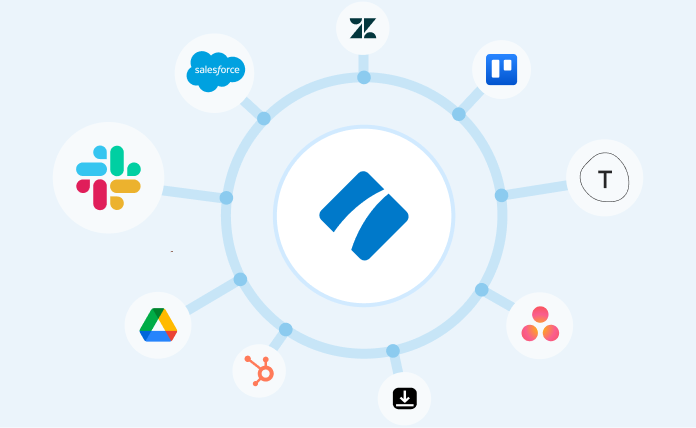
 Property management
Property management
 Human resources
Human resources
 Customer management
Customer management
 Information technology
Information technology



Benjamin Brandall
Benjamin Brandall is a content marketer at Process Street.